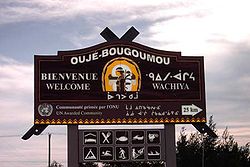Oujé-Bougoumou, Quebec
|
Oujé-Bougoumou ᐆᒉᐳᑯᒨ |
||
|---|---|---|
| Indian settlement | ||
 |
||
|
||
| Motto: The Place Where People Gather | ||
| Coordinates: 49°55′32″N 74°49′04″W / 49.92556°N 74.81778°WCoordinates: 49°55′32″N 74°49′04″W / 49.92556°N 74.81778°W | ||
| Country | Canada | |
| Province | Quebec | |
| Region | Nord-du-Québec | |
| TE | Eeyou Istchee | |
| Founded | 1992 | |
| Government | ||
| • Chief | Reggie Neeposh | |
| • Federal riding | Abitibi—Baie-James—Nunavik—Eeyou | |
| • Prov. riding | Ungava | |
| Area | ||
| • Total | 2.54 km2 (0.98 sq mi) | |
| • Land | 2.54 km2 (0.98 sq mi) | |
| Elevation | 372 m (1,220 ft) | |
| Population (2011) | ||
| • Total | 725 | |
| • Density | 285.2/km2 (739/sq mi) | |
| • Change (2006–11) |
|
|
| • Dwellings | 251 | |
| Time zone | EST (UTC−5) | |
| • Summer (DST) | EDT (UTC−4) | |
| Postal Code | G0W 3C0 | |
| Area code(s) | 418 and 581 | |
| Website | www |
|
Oujé-Bougoumou (Cree: ᐆᒉᐳᑯᒨ/Ûcêpukumû, akin to the name of the nearby town Chibougamau, the meaning of which has been lost) is the newest Cree community located on the shores of Lake Opemisca, in the Jamésie region of Quebec, Canada. It has a population of 725 people (as of the 2011 census).
Oujé-Bougoumou (referred to as "Oujé" by local residents) is accessible by a 25-kilometre (16 mi) paved road (gravel before 2008), linking to Route 113 not far from Chapais. Along with the neighbouring towns of Chibougamau and Chapais, Oujé-Bougoumou is served by the Chibougamau/Chapais airport located approximately 42 kilometres (26 mi) away on Route 113.
The Cree in the Chibougamau area had been marginalized in the 20th century by many forced relocations. After decades of such treatment, this band won recognition from the government and was granted land for a new permanent village. It was designed by architect Douglas Cardinal (known for the Canadian Museum of Civilization in Gatineau, Quebec) and was built in 1992. It has won recognition and awards for its contemporary design, which attempted to take architectural expression, economic sustainability, and environmental conservation into account.
While a majority of the youth attend the English and Cree immersion school, Waapihtiiwewan School, operating in Oujé-Bougoumou, some families send their children to French schools in nearby towns instead.
Aanischaaukamikw Cree Cultural Institute opened on November 15, 2011, after 10 years of planning and construction, at a cost of 15 million dollars. The name Aanischaaukamikw (âniscewikamikw in the southern dialect) is equivalent to "heritage centre" (âniscew-, meaning 'ancestry' and -kamikw, meaning "room" or "building") in English. It is a multi-purpose cultural institution for local cultural programs and will adapt and include programs currently provided by the James Bay Cree Cultural Education Centre and the Cree Regional Authority. It will also collaborate on the Cree-language research currently being conducted by the Cree School Board. The Cree community hopes to attract between 10,000 and 20,000 tourists each year. It stands on a semicircular lot in the middle of the village and was designed by Douglas Cardinal of Ottawa and Rubin Rotman of Montreal. The inside of the building is open to the sky and has a number of features typical of Cree culture. It has become a major tourism destination in the region, with a mission to preserve Cree culture and tell visitors about Cree history, culture, and vision. Discussions are currently underway about hotel construction nearby as a way to continue this project and continue to promote Cree and northern culture.
...
Wikipedia


